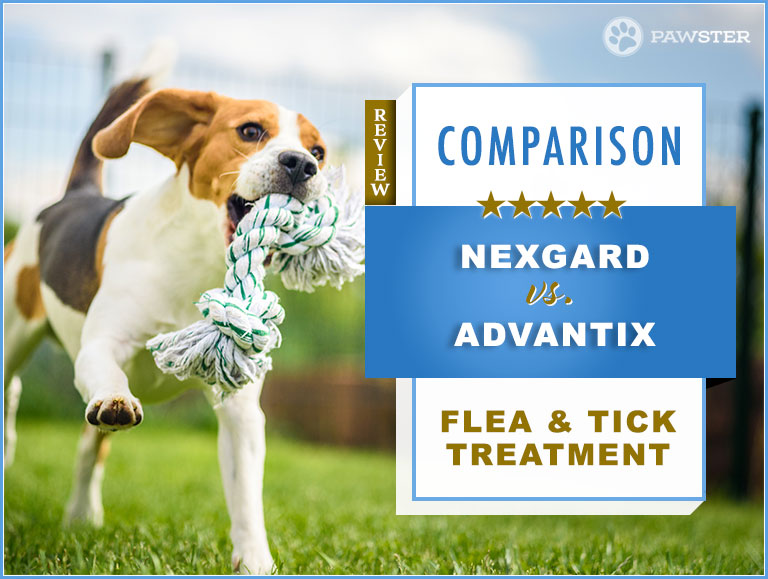Nexgard vs. Advantix : Comparison and Key Differences

Contents of Article
The eternal problem: is a chewable better than a spot-on treatment? That might be the first thing on your mind but let’s change this scenario up a little. A better question would be: What do you want from your flea prevention?
Advantix is a topical solution that repels a variety of external parasites including fleas, ticks, mosquitos, and biting lice. Nexgard is a chewable tablet that kills fleas and ticks. A lot of your decision will depend on how you answer that second question above, so let’s break it all down.
Which is Better Advantix or Nexgard for Dogs?
We love Advantix’s comprehensive external parasite protection. If your dogs spend significant time outside, you’ll get a lot out of applying Advantix. With some treatments, you don’t see a reduction in itching and irritated skin because it does nothing to repel mosquitos or biting lice. With Advantix, you’re covered.
The only reason to choose Nexgard would be if your pet has difficulties with topical applications due to skin sensitivities. The chewable is safe and offers an alternative to skin contact. Otherwise, we definitely recommend the broad-spectrum coverage of Advantix.
Which is Better Advantix or Nexgard for Cats?
Neither of these medications is made for cats and Advantix, in particular, can be dangerous. Feline versions of both medicines do not exist, so you’ll have to find a completely different flea prevention for your cats.
Although dogs and cats are both pets, the biology of both is different. Medication created for dogs doesn’t automatically transfer to cats. We want to make very clear that we do not recommend either of these medications and you should talk to your veterinarian for safe alternatives.
Our Review of Advantix and Nexgard
Both are initially used to prevent flea infestations. They rely on neurotoxins to interrupt the lifecycle of biting insects, preventing them from feeding or laying eggs. The specific toxin is different, however, as well as the application.
Key Differences Between Advantix and Nexgard
Honestly, there couldn’t be much more different about these two preventatives. Let’s take a look. Since these aren’t suitable for cats, we’ll be looking only at applications for dogs.
Application
Advantix is a spot-on treatment. It uses a plastic applicator tip to part the hair at your dog’s back to get the solution down to the skin. It slowly absorbs and after a few days is waterproof. The treatment is good for one month although frequent baths could affect the length of protection.
Nexgard is a chewable option. It comes in a beef flavored tablet meant to mimic your pet’s favorite treat. It works from your dog’s internal chemistry to create an environment deadly to fleas and ticks. It’s good for a month as well. You don’t have to worry about it being waterproof.
Other Pests
Nexgard protects your dog from fleas and ticks mainly, but other pests you’ll need other preventatives. Advantix protects your dog from a host of external parasites including mosquitos, biting flies, and lice. If your dog is outside in areas with many different biting insects, this is a better option.
Availability
Advantix doesn’t require a prescription to begin. You should always talk to your vet before starting any sort of prevention system. It’s widely available in many stores and online.
Nexgard requires a prescription from your veterinarian to start. It isn’t as widely available, but you should have no trouble finding it online or as a subscription shipment. You need to consider that as part of your overall cost and simplicity.
Nexgard and Advantix Active Ingredients Comparison
The type of neurotoxin is different for both of these medications. They work on the nervous system of the pest but are safe for your pet’s nervous system if appropriately administered.
Nexgard: Afoxolaner
Afoxolaner is a class of neurotoxin that uses your dog’s chemistry to create a biological barrier to the flea’s lifecycle. It interrupts neuron firing, causing spasms and eventually death. Fleas aren’t able to lay eggs, so the entire life cycle is interrupted.
Side effects are rare, but ones that sometimes occur are stomach issues, diarrhea, and vomiting. See your vet if anything else seems out of the ordinary.
Advantix: Imidacloprid/ Permethrin/Pyriproxyfen
This triple neurotoxin is a broader spectrum preventative against biting insects. The combination widens the effectiveness so that nearly every biting insect is covered. It doesn’t require a prescription, but it’s still very effective.
Side effects are rare, but if they occur, it’s usually some sort of skin irritation. Itching, lethargy, and rashes can also occur. Again, see your vet if anything happens.
Which Treatment is the Best Priced?
Really, there’s very little difference in price between the two treatments. Advantix often comes in six dose packages while Nexgard comes in three, but the price is comparably the same. However, you’ll have to add in the soft cost of going to the vet for a prescription with Nexgard. Also, Advantix has a wider range of preventative capabilities. Advantix has a better overall value for the price.
Which Do We Recommend?
We recommend Advantix because of the wide range of preventatives and because of the availability. Advantix is an excellent spot on treatment good for dogs that spend time outside and don’t have any sort of skin irritations. We know first-hand how difficult it is when your dog is swarmed by mosquitos, so this is a great option.
We’d be wary of applying it to dogs with very sensitive skin. Also, if you’ve got multiple pets plus children, it can be difficult to apply a spot-on treatment and keep everyone separated. In this case, you might consider the chewable. However, as long as you can successfully prevent your children from touching the application site for a few days and keep dogs apart as well, we see no reason to switch to Nexgard.
7 Treatment Application Tips
We have a few things you should keep in mind for either preventative to make the application as successful as possible.
For Spot-On Treatments:
- It’s essential that you don’t bathe your pets for about two days before and after any spot on treatment. Spot on treatments works best with the natural oils in the coat to help distribute the solution throughout the coat. Without those, the treatment doesn’t absorb as well. Bathing your dog before the medication has had a chance to absorb reduces its effectiveness as well. Make sure you honor that two-day mark before and after for best results.
- If your pet has trouble sitting still for the application, you can use exercise to get some of that energy out. If you’ve got multiple dogs, this can also help reduce contact after the treatment. Go for a longer walk than usual or play your pet’s favorite game for plenty of time. When you notice your pet beginning to show signs of fatigue, this is the perfect time for application. Your dog is more likely to sit still during the application and more likely to lay down afterward, keeping the overall mess down.
- Make sure you check the area frequently for signs of irritation and broken skin. Before applying the treatment, do a quick assessment of your dog’s skin to make sure that the skin is healthy and that there are no cuts or rashes that could cause further irritation. Afterward, periodically check to make sure your dog hasn’t had a reaction to the medication. Even if you’ve given it before, your dog can still develop sensitivities to a medication that can cause alarm. If you notice your dog still scratching after the application, you may want to have your vet further assess the irritation.
For Chewable Treatments:
- Most dogs love chewable treatments, but some dogs still don’t. For stubborn dogs, you could try the modified sandwich method. Take two of your pet’s favorite treats and allow your dog to smell them. Give one treat and quickly follow up with the chewable. Give your pet the final treat, all in quick succession. Many pets will be so focused on the good treats that they don’t notice or mind the chewable.
- If that doesn’t work, try dipping the treat in something with a strong smell, such as the juice from tuna or wrapping it in cheese. It could help mask the treat and cause your dog to take it before it notices that the chewable exists. Many dogs feed off your excitement, so if you administer it excitedly, you might be able to slip it by.
- Some dogs love to catch things. You could also try making your dog sit and gently tossing the treat to the dog. Your dog can catch it and swallow it before your dog realizes that it’s a chewable tablet. For many dogs, the thrill of catching a treat in the air is better than the treat itself, and it won’t matter that it’s a flea preventative.
- With chewables, it’s crucial that you carefully watch your dog’s diet if you opt for chewables. The first time you give the chewable, don’t provide any new food or drink for at least two days beforehand. That way, if your dog has a reaction, you know it’s to the flea prevention and not to a new food. Also, follow up with plenty of water. If your dog seems lethargic, has stomach issues, or loss of appetite afterward, your dog may not want to have anything to do with the chewable again, regardless of what was at fault. Just to be sure, minimize new foods and treats beforehand for best results.
Final Thoughts
We are big fans of chewable flea prevention methods, but with Advantix, the wide range of external parasites covered makes it hard for us to choose Nexgard. It’s got such power against insects outside, we think your pet will be a lot better off with the spot-on treatment than with the chewable.
We want to remind you that neither of these medications is suitable for cats. Formulas need to be specifically for feline biology to work. Administering something made for dogs is ineffectual at best and dangerous at the very worst. If your cat also needs a prevention treatment, it’s best to find an alternative by talking to your veterinarian. There are plenty of options out there for cats.
Nexgard should be used if your pet has particularly sensitive skin or you just don’t think you can keep your children or other pets away from the application site. It’s better to be safe than to worry about accidentally contaminating other pets or especially your children. However, for a more comprehensive approach and value for the money, Advantix has our recommendation.
Is a spot-on treatment the best option for you or does the application site make you worry about children and other pets? Let us know your thoughts in the comments below.






